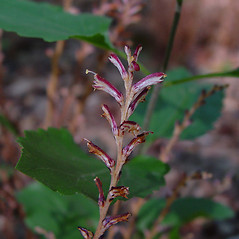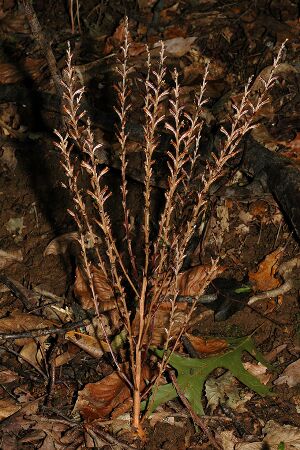Beechdrops: Difference between revisions
No edit summary |
No edit summary |
||
| Line 1: | Line 1: | ||
Beechdrops (Epifagus virginiana) is an obligate parasitic plant, belonging to the family Orobanchaceae, that obtains nutrients solely from the roots of American beech trees. The name Epifagus originates from the Greek prefix "epi", translating to "upon", while "Fagus" is the genus name of beech. | Beechdrops (Epifagus virginiana) is an obligate parasitic plant, belonging to the family Orobanchaceae, that obtains nutrients solely from the roots of American beech trees. The name Epifagus originates from the Greek prefix "epi", translating to "upon", while "Fagus" is the genus name of beech. | ||
[[File:Epifagus - Épifage de Virginie - Beechdrops (6139587346).jpg|thumb|Beechdrops]] | |||
== Taxonomy == | == Taxonomy == | ||
Revision as of 20:59, 27 April 2022
Beechdrops (Epifagus virginiana) is an obligate parasitic plant, belonging to the family Orobanchaceae, that obtains nutrients solely from the roots of American beech trees. The name Epifagus originates from the Greek prefix "epi", translating to "upon", while "Fagus" is the genus name of beech.
Taxonomy
| Kingdom | Phylum | Class | Order | Family | Genus | Species | |
|---|---|---|---|---|---|---|---|
| Classification | Plantae | Angiosperms | Magnoliopsida | Lamiales | Orobanchaceae | Epifagus, Nutt. | E. virginiana |
The genus Epifagus is monotypic, only containing E. virginiana within it.
Description and Characteristics
Beechdrops generally reach heights of 6-20 in. (15-50 cm.) at maturity. The plants are reddish brown in coloration, commonly being mistaken as woody or dying plants. However, beechdrops are herbaceous. The stems are usually a light brown shade, with vertical purple stripes that may darken with age. The leaves are underdeveloped and difficult to distinguish, appearing similar to small scales. Flowers are about ½" (1.3 cm) long, shaped like a tube, sometimes square-edged, appearing alternately along the stems, a mixture of deep red/purple and white or yellow. From a distance their color is brownish, blending with that of the stems, so the flowers are easily overlooked. They bloom from August to October.
Hosts and Impacts
Beechdrops grows on shallow roots at varying distances from the trunk of F. grandifolia. The parasite develops a haustorium structure that penetrates and grows into beech roots to extract nutrients, as the beechdrops plant is not able to photosynthesize or produce its own food. Without the presence of beech trees, Beechdrops cannot survive or reproduce.
Life Cycle
A fairly inconspicuous brown stem produces two types of flowers, cleistogamous flowers that self-pollinate without ever opening, and chasmogamous flowers that open, but are often sterile. The roots of the host release a chemical that trigger the germination of E. virginiana. It is believed that the older the host tree, the more this chemical is released. Seeds from E. virginiana are small and are dispersed by rainwater. Between dispersal and germination, seeds experience a cellular change, the embryo changes colors and its cells develop granules.
Habitats and Range
This parasitic plant is native to North America and can commonly be found along the edges of temperate forests. Chasmogamous flowers are cross pollinated flowers that grow at the top of the plant and are sometimes sterile. Cleistogamous flowers are self-fertile, these flowers grow at the base of the plant.[10] Seeds from E. virginiana are small and are dispersed by rainwater. The beech drops w
Sources
[1] Native Plant Trust: Go Botany, Epifagus virginiana — beech-drops. From https://gobotany.nativeplanttrust.org/species/epifagus/virginiana/
[2] From https://illinoiswildflowers.info/woodland/plants/beechdrops.htm
[3]
[4]
[5]

